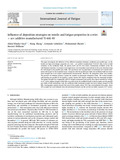JavaScript is disabled for your browser. Some features of this site may not work without it.
| dc.contributor.author | Syed, Abdul Khadar | |
| dc.contributor.author | Zhang, Xiang | |
| dc.contributor.author | Caballero, Armando | |
| dc.contributor.author | Shamir, Muhammad | |
| dc.contributor.author | Williams, Stewart | |
| dc.date.accessioned | 2021-04-16T11:25:43Z | |
| dc.date.available | 2021-04-16T11:25:43Z | |
| dc.date.issued | 2021-04-15 | |
| dc.identifier.citation | Syed AK, Zhang X, Caballero A, et al., (2021) Influence of deposition strategies on tensile and fatigue properties in a wire + arc additive manufactured Ti-6Al-4V. International Journal of Fatigue, Volume 149, August 2021, Article number 106268 | en_UK |
| dc.identifier.issn | 0142-1123 | |
| dc.identifier.uri | https://doi.org/10.1016/j.ijfatigue.2021.106268 | |
| dc.identifier.uri | https://dspace.lib.cranfield.ac.uk/handle/1826/16588 | |
| dc.description.abstract | This paper investigates the influence of two different deposition strategies, oscillation and parallel pass, on the tensile and high cycle fatigue properties of a wire + arc additive manufactured Ti-6Al-4V alloy in the as-built condition. In the oscillation build, the plasma torch and the wire feeder continuously oscillated across the wall thickness direction. In contrast, four single layers were deposited consecutively in the same direction along the wall length in the parallel pass build. Test specimens were manufactured in horizontal and vertical orientation with respect to the deposited layers. Compared with the parallel pass build, the oscillation build had lower static strength due to its coarser transformation microstructure. However, the elongation values were similar. The presence of columnar primary β grains has resulted in anisotropic elongation values. The vertical samples with loading axis parallel to the primary β grains showed 40% higher elongation than the horizontal samples. The fatigue strength was comparable with its wrought counterpart and greater than typical material by casting. At 107 cycles, fatigue strength of 600 MPa was achieved for the oscillation build vertical samples and the parallel pass build in both orientations. Only the oscillation build horizontal samples had lower fatigue strength of 500 MPa. Fractography analysis showed that most of the samples (about 70%) had crack initiation from pores, about 20% samples had crack initiated from microstructural features and the rest did not failed (runouts at 107 cycles). | en_UK |
| dc.language.iso | en | en_UK |
| dc.publisher | Elsevier | en_UK |
| dc.rights | Attribution-4.0 International | * |
| dc.rights.uri | http://creativecommons.org/licenses/by/4.0/ | * |
| dc.subject | TensileFatigue | en_UK |
| dc.subject | Titanium alloys | en_UK |
| dc.subject | WAAM | en_UK |
| dc.subject | Additive manufacturing | en_UK |
| dc.title | Influence of deposition strategies on tensile and fatigue properties in a wire + arc additive manufactured Ti-6Al-4V | en_UK |
| dc.type | Article | en_UK |
Files in this item
The following license files are associated with this item:
This item appears in the following Collection(s)
-
Staff publications (SATM) [4472]

